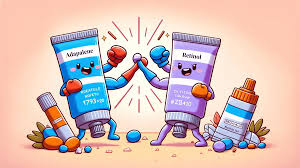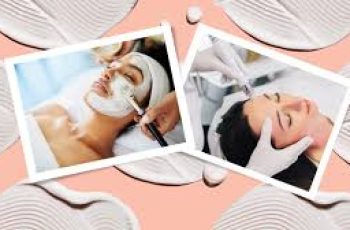
Adapalene vs Retinol: A Dermatologist’s Guide
As a dermatologist, I often discuss retinoids with my patients and the differences in the various treatment options available for skin conditions such as acne, signs of aging, and hyperpigmentation. Among the myriad of choices, retinoids, particularly adapalene and retinol, frequently come up in our conversations. It can be hard to choose which one to use as they are both available without a prescription. Both are derivatives of Vitamin A and work by promoting cell turnover and collagen production, but they differ a little in their mechanism of action, strength, and availability. In this guide, I will help you understand the differences between adapalene and retinol and how to choose which one to use in your skin care regimen.
If you want customized advice on which products are best for you r skin type, take the skin type quiz that I use in my dermatology practice.
Adapalene and Retinol: How They Work
Adapalene and retinol, while both retinoids, operate slightly differently at the cellular level. Adapalene is a synthetic retinoid specifically formulated to treat acne. It comes in many brand names such as Differin and Cabtreo (a combination acne prodcut that also has benzoyl peroxide and clindamycin). It is found in over the counter formulations such as Proactive and La Roche Posay Effaclar.
Adapalene binds to specific retinoic acid receptors (RAR) in the skin, normalizing the process of keratinization and desquamation. This action prevents the formation of acne lesions and promotes quicker healing of existing pimples. Adapalene selectively binds to RAR beta (β) and gamma (γ) but does not interact with RAR alpha (α). This selectivity of adapalene contributes to its unique efficacy and side effect profile in treating acne
Retinol , on the other hand, is a natural form of vitamin A that is converted into retinoic acid in the skin. Retinoic acid (tretinoin) binds to all three subtypes of retinoic acid receptors (RARs): RAR alpha (α), beta (β), and gamma (γ). Because retinol must undergo conversion to retinoic acid, retinol is generally considered less potent than adapalene. There are too many brands of retinol to list here, but some can be seen below.
[[T11]]
Acne
Adapalene stands out in the treatment of acne due to its potent anti-inflammatory properties and its ability to prevent the formation of microcomedones, the precursor to all acne lesions. Clinical studies have shown adapalene to be as effective as tretinoin, another prescription-strength retinoid, in treating acne, but with a lower incidence of irritation and side effects. Adapalene is FDA approved to treat acne but retinol is not.
Skin Aging
While adapalene is primarily used for acne, it has also shown promise in addressing signs of skin aging. However, retinol is more commonly recommended for this purpose. Its ability to penetrate deeper into the skin allows it to effectively stimulate collagen production, resulting in reduced appearance of fine lines and improved skin texture. Tretinoin has been approved by the FDA to treat skin aging but adapalene and retinol have not.
Hyperpigmentation
Both adapalene and retinol can be effective in treating melasma and dark spots on the skin by accelerating cell turnover and removing pigmented cells. However, retinol, with its broader mechanism of action, may be more beneficial for those specifically looking to even out skin tone and fade dark spots.
These work best when combined with tyrosinase inhibitors.
Scars
There are not any significant studies that compare how well retinol and adapalene work on scars. Although there are studies of tretinoin on scars that suggest that retinol may have some efficacy (9), studies on retinol have not been done. There have been studies to show that adapalene can help improve scars (7,8), so if you have scars that you want to treat, I suggest using adapalene over retinol. However, tazarotene is probably the most effective retinoid for scars.
Comparing Adapalene and Retinol
There is not a huge difference in adapalene and retinol. Adapalene is more effective in acne and is FDA approved for this while retinol is not approved as an acne medication. Adapalene ‘s selective action on RAR β and γ has been shown to be particularly effective in the treatment of acne. These receptors influence processes such as keratinocyte differentiation and proliferation, leading to reduced formation of comedones and an anti-inflammatory effect that is beneficial in acne management.
Retinol is used as an acne treatment because in the skin it converts to retinoic acid (which is the same as tretinoin) and has broad RAR activation. However, its conversion process is less efficient, and its effects on acne are generally considered milder compared to adapalene and tretinoin.
For acne treatment, adapalene is more effective than retinol due to its selective binding to RAR β and γ, which directly targets acne pathogenesis mechanisms with a favorable profile in terms of stability and irritation.
Adapalene is available with and without a prescription. Here are examples of adapalene that you can get without a prescription.
Side Effects
Adapalene and retinol exhibit similar profiles when it comes to side effects. When used correctly, both are generally well-tolerated and associated with fewer side effects compared to other retinoids. They both may cause skin irritation, dryness, skin stinging, and redness, but these effects are usually mild and decrease with continued use.
With both, users often report increased sensitivity, peeling, redness, and dryness during the initial weeks of treatment.
With both you need to make sure you are using them with the correct cleansers and moisturizers for your Baumann Skin Type.


